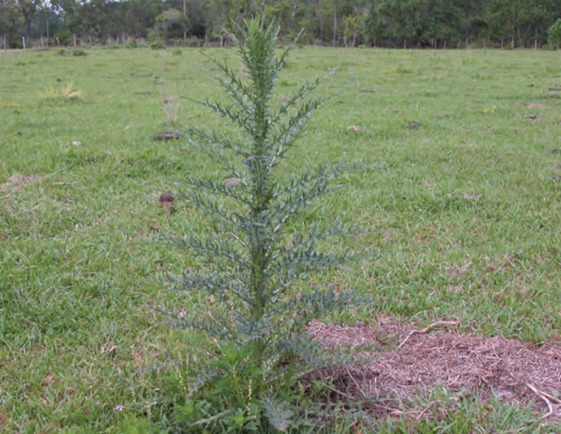
by Ray Bodrey | Apr 7, 2022
The thistle has long been an enemy of ranchers, county roadside maintenance crews and homeowners. Often difficult to control, it causes both headaches for producers, in reduction of grazing for livestock as well as being an eyesore for gardening enthusiasts. There are nine different species of thistle in Florida. Most of these are closely related, therefore the control protocols are the same. Only one species is a perennial, and all others are biennial. A biennial plant grows from seed in one year and produces seed for the next.
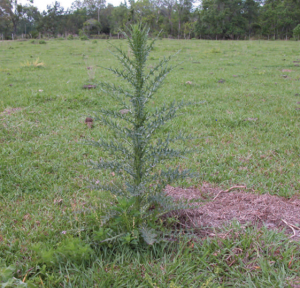
Thistle that has begun to bolt. Photo Credit: Dr. Jason Ferrell, University of Florida/IFAS Agronomy Department-Weed Science.
It’s important to understand the biology of the thistle in regards of seeking control of this fast spreading weed. This plant will grow a taproot and a cluster of leaves in the first year. This is known as the rosette stage. In the second year, a stalk will appear from the center of the rosette. This is called “bolting”. A seed head will form once the bolting stage is complete. Amazingly, one thistle plant can amass 4,000 seeds. The plant faces its demise after releasing the seeds. The rosette growth stage is mostly during the winter months with bolting occurring from January to July. This is important to note when battling this persistent weed.
As for control, preventing the thistle from producing seed is the most important management measure. Otherwise, little can be done to stop the outbreak of the weed. For homeowners, manually removing the rosette and tap root by hand is effective with small stands. Be careful and wear protective coverings on your hands and arms. Keep in mind, the plant will come back if the tap root is not fully removed.
Other physical control methods, like mowing, have mixed results. This can be effective if mowing occurs after the bolting stage has occurred, but before the seed head forms. However, this is tricky, as thistle plants often do not bloom at the same time.
Thistles in the rosette stage are very susceptible to herbicides. Although, applying a herbicide after the seed head has formed has little effect on control. Herbicides containing 2,4-D are very effective for landscapes. Timing of application is critical. The key to controlling this weed is by scouting and identifying stands as early as possible.
If you’re a beekeeper, there is an upside to this weed. Delicious honey can be made from the thistle bloom.
For more information on thistle, please contact your local county extension office.
Supporting information for this article can be found in the UF/IFAS EDIS Publication, “Thistle Control in Pastures” by Dr. Brent Sellers and Dr. Jason Ferrell.
UF/IFAS Extension is an Equal Opportunity Institution.

by Beth Bolles | Mar 31, 2022
The February Q&A on Growing Tomatoes offered valuable tips for the home gardener to be successful with tomatoes in 2022. Below are the reference materials related to specific questions that were asked.
Let’s start out with the panels favorite tomatoes including hybrids and heirlooms.
Evan: Supersweet 100, Sungold
Larry: Amelia, Brandywine, Cherokee Purple
Sam: Better Boy, Tasti Lee, Sweethearts
Matt: Mountain Magic, Mountain Rouge, Bella Rosa
Daniel: Black cherry and Big Beef
Why are tomatoes red?
Can we grow tomatoes year around?
I have very sandy/loamy soil. Do I have a chance at successfully growing tomatoes?
What is the best time to start tomatoes in North Florida?
If one grows in raised beds, should one rotate where in the bed tomatoes are planted?
If you plant tomatoes in mid-March, how long will they continue to produce fruit?
I’m thinking of trying hydroponic gardening on a few tomato plants this year. Do you think a 50/50 mix of perlite and vermiculite would be a good approach for a soil medium? I’d like to use 5-gallon buckets and keep maintenance to a minimum.
What tomatoes grow best in inland Bay County? Coastal vs inland considerations.
Best type for all day sun (speak to tomatoes light requirements)
What is the best tomato variety for Northwest Florida? I need one go-to variety for both regular tomatoes and cherry type.
How to get more tomatoes, less vine?
My tomatoes get black on the bottom and rot. What causes this and how do I prevent it?
Do tomatoes need a lot of water?
Why do my tomatoes split/burst/crack while on the vine?
Any suggestions for how to handle especially wet years like last summer? My tomatoes really suffered.
How do I keep the leaves from getting dark spots that spread and kills foliage?
How do you string tomatoes vine to a stake?
What causes catfacing?
Every year I’m having trouble with an amazing amount of insect infestations on my tomatoes & peppers I grow in containers. What can I do to help?
How do marigolds (which variety) or basil aid tomatoes?
Please talk about save tomato seeds to grow. Some can’t afford to buy potted tomato plants.
Can you add nutrients into the soil from last year’s tomatoes to reuse again this year?
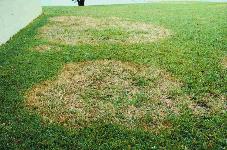
by Sheila Dunning | Mar 31, 2022
 As the temperatures warm into the 70’s and the rain chance remains good, keep an eye open for disease in your lawn. Large patch disease is common in turfgrass this time of the year. It is caused by the fungus Rhizoctonia solani. The fungus is present in the soil and thatch layer year-round. When the temperatures rise into the 60’s and 70’s it begins to spread. Large patch thrives under these conditions, especially when the soil is wet. With frequent showers the disease spreads quickly. The first symptom of large patch is circular, discolored areas within the lawn. The outer borders of the patches are orange to yellowish in color. In the center of the circle there are grass blades trying to green up again. They are usually unsuccessful, resulting in odd-shaped patches of dying grass that begin to connect to each other. A simple field diagnostic techniques to confirm large patch disease is to pull on the diseased grass shoots near the edge of the circle. The blades will come loose from the stolon easily. At the base of the leaves the stem and sheaths will appear dark brown and rotten. Yes, it is large patch.
As the temperatures warm into the 70’s and the rain chance remains good, keep an eye open for disease in your lawn. Large patch disease is common in turfgrass this time of the year. It is caused by the fungus Rhizoctonia solani. The fungus is present in the soil and thatch layer year-round. When the temperatures rise into the 60’s and 70’s it begins to spread. Large patch thrives under these conditions, especially when the soil is wet. With frequent showers the disease spreads quickly. The first symptom of large patch is circular, discolored areas within the lawn. The outer borders of the patches are orange to yellowish in color. In the center of the circle there are grass blades trying to green up again. They are usually unsuccessful, resulting in odd-shaped patches of dying grass that begin to connect to each other. A simple field diagnostic techniques to confirm large patch disease is to pull on the diseased grass shoots near the edge of the circle. The blades will come loose from the stolon easily. At the base of the leaves the stem and sheaths will appear dark brown and rotten. Yes, it is large patch. 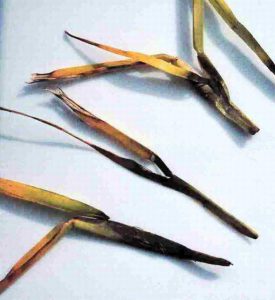 If the weather gets colder or hotter very quickly, the disease will go back into dormancy. Looking at the long range temperature predictions, cool night and warm days are likely to continue for awhile. So, start looking for a fungicide or two or contact your pest control service. However, remember fungicides don’t cure existing problems. They are utilized as a protectant for the unaffected portions of the grass. When favorable conditions are present, the turf should be sprayed in order to keep the fungus from penetrating the grass blades. Repeat applications will be needed for as long as the weather is cool and wet. Check the product label for the correct intervals. Several cultural practices promote large patch infection including over-fertilization, over-irrigation, low mowing height, poor drainage and excess thatch. This spring after the grass has greened-up on its own is a good time to look at these factors and make corrections. Keep a close eye because as soon as the temperatures drop again in the fall, large patch can reappear if the corrections were not complete. For more information: https://edis.ifas.ufl.edu/lh044
If the weather gets colder or hotter very quickly, the disease will go back into dormancy. Looking at the long range temperature predictions, cool night and warm days are likely to continue for awhile. So, start looking for a fungicide or two or contact your pest control service. However, remember fungicides don’t cure existing problems. They are utilized as a protectant for the unaffected portions of the grass. When favorable conditions are present, the turf should be sprayed in order to keep the fungus from penetrating the grass blades. Repeat applications will be needed for as long as the weather is cool and wet. Check the product label for the correct intervals. Several cultural practices promote large patch infection including over-fertilization, over-irrigation, low mowing height, poor drainage and excess thatch. This spring after the grass has greened-up on its own is a good time to look at these factors and make corrections. Keep a close eye because as soon as the temperatures drop again in the fall, large patch can reappear if the corrections were not complete. For more information: https://edis.ifas.ufl.edu/lh044
The Institute of Food and Agricultural Sciences (IFAS) is an Equal Opportunity Institution authorized to provide research, educational information and other services only to individuals and institutions that function with non-discrimination with respect to race, creed, color, religion, age, disability, sex, sexual orientation, marital status, national origin, political opinions or affiliations. For more information on obtaining other extension publications, contact your county Cooperative Extension service.
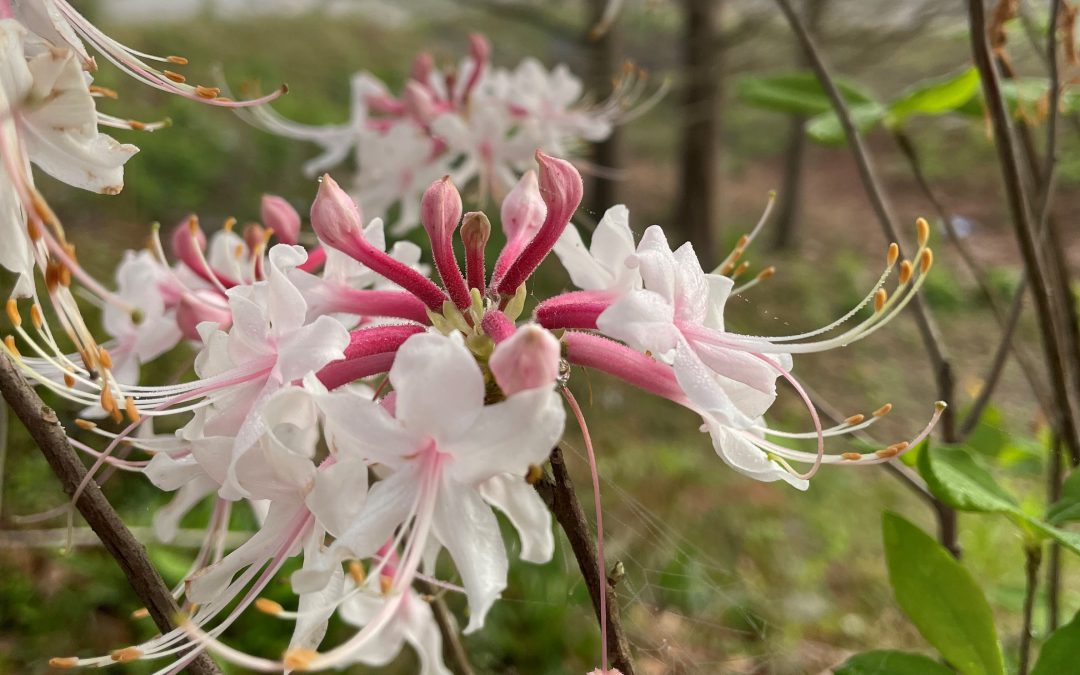
by Matt Lollar | Mar 31, 2022
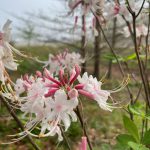
Piedmont azalea (Rhododendron canescens) flowers. Photo Credit: Matt Lollar, University of Florida/IFAS Extension – Santa Rosa County
Native azaleas are stunning this time of year. These deciduous shrubs (and sometimes small trees) often go unnoticed until they bloom in the spring. Three species native to Florida are the piedmont azalea (Rhododendron canescens), the Florida flame azalea (Rhododendron austrinum), and the swamp azalea (Rhododendron viscosum). Piedmont azaleas have whitish to pinkish blooms, Florida flame azaleas have yellow to orange blooms, and the white blooms. All three species have a wonderful honeysuckle-like, sweet fragrance. All three serve as outstanding focal points in the landscape.
Native azaleas and other deciduous azaleas have varying site preferences. Like other azaleas, piedmont and Florida flame azaleas prefer moist, well-drained, acidic soils. However, as the name would suggest, the swamp azalea tolerates wetter locations. All three species prefer partial shade (morning sun and afternoon shade are best) locations and can grow up to 15 feet tall.
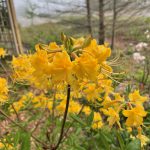
Rhododendron x ‘Aromi Sunny-Side-Up’ in bloom. Photo Credit: Matt Lollar, University of Florida/IFAS Extension – Santa Rosa County
In addition to these beautiful native azaleas, a number of deciduous hybrids have been developed. Aromi hybrids have been bred to tolerate heat and humidity. These azaleas were developed from four native species ()from Gene Aromi in Mobile, AL. He developed more than 100 cultivated varieties (also referred to as cultivars). Popular cultivars in the market include ‘Centerpiece’, ‘Aromi Sunrise’, and ‘Aromi Sunny-Side-Up’.
Deciduous azaleas do not require a lot of fertilizer. A controlled release or slow release, acid forming (specifically formulated for azaleas or blueberries) fertilizer is recommended. A fertilizer nutrient ratio of or close to 2-1-1 (N-P-K) should be selected. Plants should be fertilized in spring or early summer, never in the fall or winter.
More information on azales, native and nonnative, can be found on the UF/IFAS Gardening Solutions website.
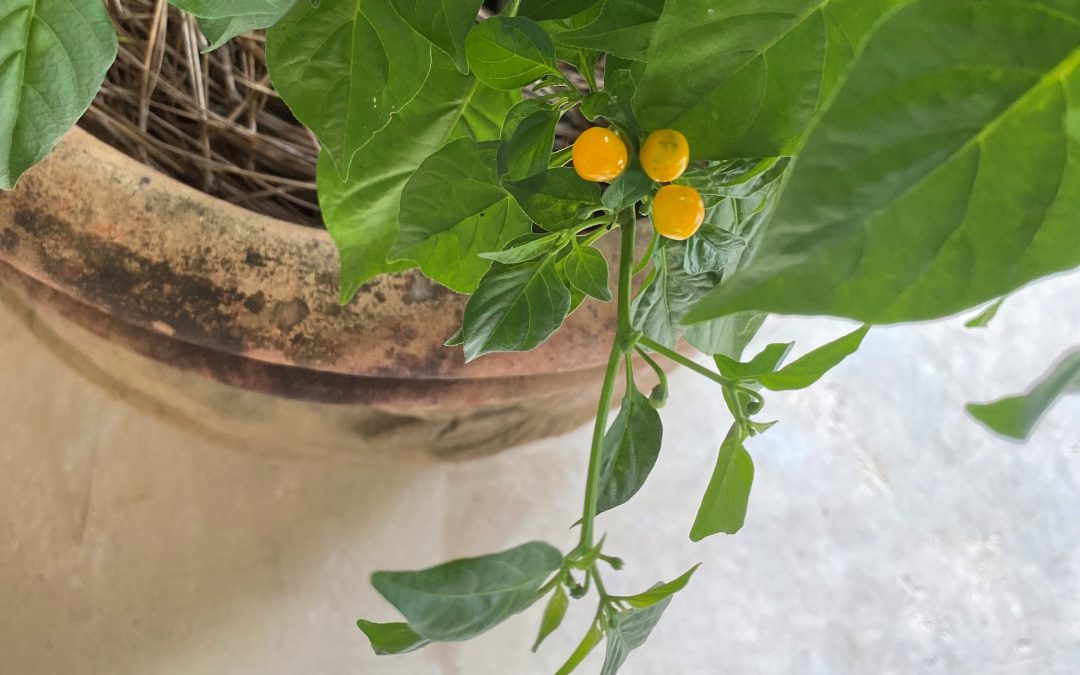
by Matthew Orwat | Mar 31, 2022
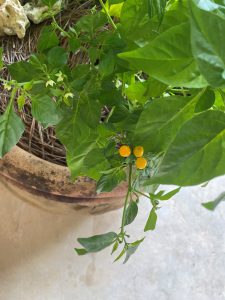
Fruit of the charapita pepper. Image Credit: Stephanie Gainer, UF / IFAS Extension Master Gardener Volunteer
As spring has officially sprung, my mind has been turning to what delectable delights we may be able to grow this year in our Extension Demonstration Vegetable Garden. A few years ago, I was introduced to the very flavorful pepper, aji charapita (to be referred to as charapita) by one of my master gardener volunteers, Stephanie Gainer. When we met Stephanie and I discovered we both shared a love for spicy cuisine, so she introduced me to the charapita. I thought I had heard of all the peppers in cultivation, but when I heard this unusual flavorful pepper, I was astonished!
The charapita pepper is a small pea sized pepper that begins purplish brown and is a bright orange/yellow when ripe. It is a native of the Peruvian Amazon and holds the designation of being the most expensive pepper when sold by dry weight. Reasoning for this is two-fold, since it is very difficult to germinate, and the fruit is very small in size. They also require warm nights to fruit, so production is not suited for every climate. Also, we have found that they do best in the central Florida Panhandle when given afternoon shade after 6-8 hours of full sun in the morning. Aside from these requirements, cultivation is very similar to other hot peppers. As a compact plant, it is ideal for container culture.
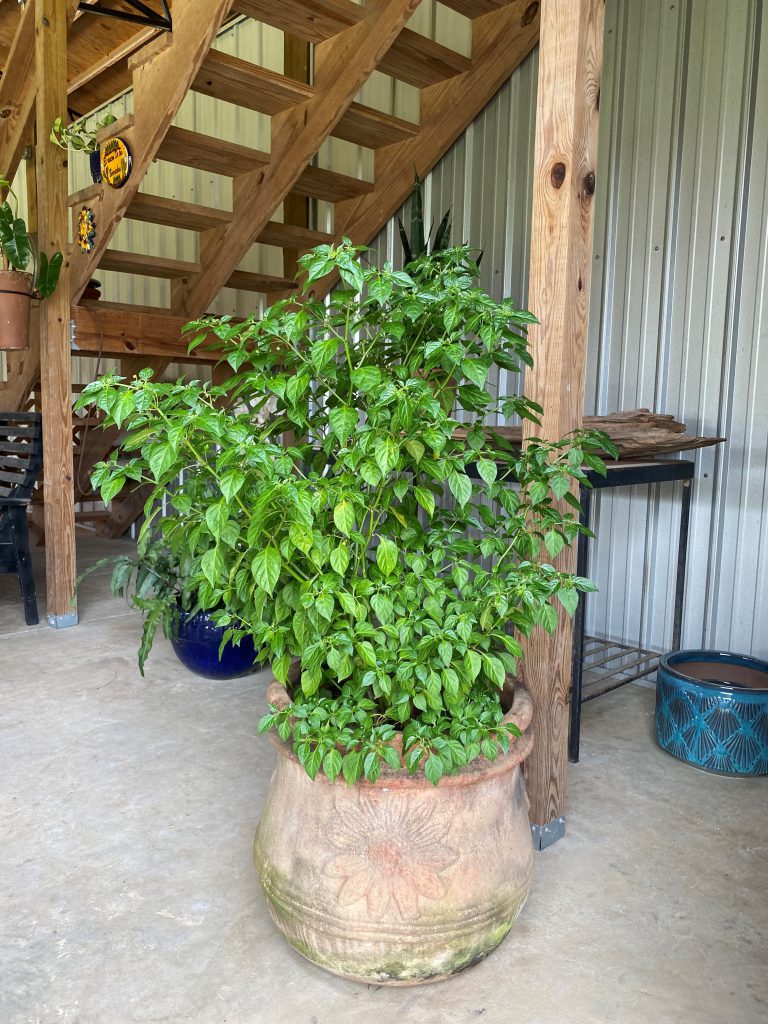
Large but compact charapita pepper plant in a container. Image Credit: Stephanie Gainer, UF / IFAS Master Gardener Volunteer
When germinating seed, it is recommended to grow them indoors, 8-12 weeks before the last frost date in your area, in a very sunny location with a heating pad at the base of the starting pots. Once temperatures are consistently above 50°F during the night it is ok to set them out in the garden.
As with other hot peppers, they should be fertilized with a standard vegetable fertilizer blend at planting and periodically thereafter based on the needs of the plant in ones individual garden.
Charapita has a unique citrus and tropical fruit aroma and taste, providing the usual heat associated with cayenne peppers (about 50,000 Scoville heat units). It is often used fresh in small amounts when flavoring rice and seafood dishes but is also used as a dried ingredient for chili and grilled meat preparations. Some have said it is best added at the end of cooking. Most likely, it would be an excellent addition added fresh to finely chopped salads, to spice up traditional chimichurri or in Pico de Gallo.
In the central Florida Panhandle, we have been unsuccessful at overwintering plants so far, but others by the coast or in central or south Florida might have more success.
For more information about growing peppers in your home garden, please follow this link for a Gardening Solutions publication on the topic.
An Extension colleague of mine, Gary Bachman of Mississippi State University, has penned this excellent article about specialty peppers with a great pickling recipe for charapita. Happy growing!











